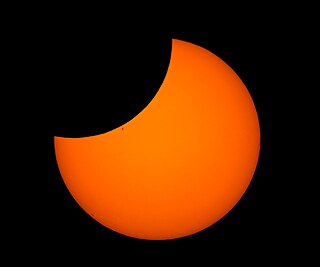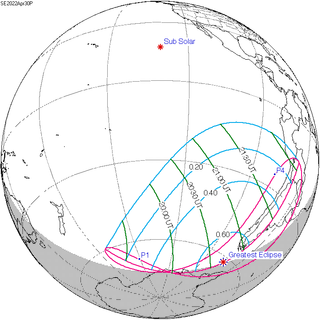
Summary
A partial solar eclipse took place on April 30, 2022.[1][2][3] A solar eclipse occurs when the Moon passes between Earth and the Sun, thereby totally or partly obscuring the image of the Sun for a viewer on Earth. A partial solar eclipse occurs in the polar regions of the Earth when the center of the Moon's shadow misses the Earth.
| Solar eclipse of April 30, 2022 | |
|---|---|
 Partial from the CTIO | |
 Map | |
| Type of eclipse | |
| Nature | Partial |
| Gamma | −1.1901 |
| Magnitude | 0.6396 |
| Maximum eclipse | |
| Coordinates | 62°06′S 71°30′W / 62.1°S 71.5°W |
| Times (UTC) | |
| Greatest eclipse | 20:42:36 |
| References | |
| Saros | 119 (66 of 71) |
| Catalog # (SE5000) | 9557 |
Images edit
Animated path
Related eclipses edit
Eclipses of 2022 edit
- A total lunar eclipse on May 16.
- A partial solar eclipse on October 25.
- A total lunar eclipse on November 8.
Solar eclipses of 2022–2025 edit
This eclipse is a member of a semester series. An eclipse in a semester series of solar eclipses repeats approximately every 177 days and 4 hours (a semester) at alternating nodes of the Moon's orbit.[4]
| Ascending node | Descending node | |||||
|---|---|---|---|---|---|---|
| Saros | Map | Gamma | Saros | Map | Gamma | |
| 119 Partial from CTIO, Chile |
2022 April 30 Partial |
−1.19008 | 124 Partial from Saratov, Russia |
2022 October 25 Partial |
1.07014 | |
| 129 Total from East Timor |
2023 April 20 Hybrid |
−0.39515 | 134 Annular from Campeche, Mexico |
2023 October 14 Annular |
0.37534 | |
| 139 Total from Indianapolis, USA |
2024 April 8 Total |
0.34314 | 144 | 2024 October 2 Annular |
−0.35087 | |
| 149 | 2025 March 29 Partial |
1.04053 | 154 | 2025 September 21 Partial |
−1.06509 | |
Saros 119 edit
It is a part of Saros cycle 119, repeating every 18 years, 11 days, containing 71 events. The series started with partial solar eclipse on May 15, 850 AD. It contains total eclipses on August 9, 994 AD and August 20, 1012, with a hybrid eclipse on August 31, 1030. It has annular eclipses from September 10, 1048, through March 18, 1950. The series ends at member 71 as a partial eclipse on June 24, 2112. The longest duration of totality was only 32 seconds on August 20, 1012. The longest duration of annularity was 7 minutes, 37 seconds on September 1, 1625. The longest duration of hybridity was only 18 seconds on August 31, 1030.
| Series members 54–70 occur between 1801 and 2100: | ||
|---|---|---|
| 54 | 55 | 56 |
| December 21, 1805 |
January 1, 1824 |
January 11, 1842 |
| 57 | 58 | 59 |
| January 23, 1860 |
February 2, 1878 |
February 13, 1896 |
| 60 | 61 | 62 |
| February 25, 1914 |
March 7, 1932 |
March 18, 1950 |
| 63 | 64 | 65 |
| March 28, 1968 |
April 9, 1986 |
April 19, 2004 |
| 66 | 67 | 68 |
| April 30, 2022 |
May 11, 2040 |
May 22, 2058 |
| 69 | 70 | |
| June 1, 2076 |
June 13, 2094 | |
Metonic series edit
The metonic series repeats eclipses every 19 years (6939.69 days), lasting about 5 cycles. Eclipses occur in nearly the same calendar date. In addition, the octon subseries repeats 1/5 of that or every 3.8 years (1387.94 days). All eclipses in this table occur at the Moon's ascending node.
| 21 eclipse events, progressing from south to north between July 13, 2018, and July 12, 2094 | ||||
|---|---|---|---|---|
| July 12–13 | April 30-May 1 | February 16–17 | December 5–6 | September 22–23 |
| 117 | 119 | 121 | 123 | 125 |
| July 13, 2018 |
April 30, 2022 |
February 17, 2026 |
December 5, 2029 |
September 23, 2033 |
| 127 | 129 | 131 | 133 | 135 |
| July 13, 2037 |
April 30, 2041 |
February 16, 2045 |
December 5, 2048 |
September 22, 2052 |
| 137 | 139 | 141 | 143 | 145 |
| July 12, 2056 |
April 30, 2060 |
February 17, 2064 |
December 6, 2067 |
September 23, 2071 |
| 147 | 149 | 151 | 153 | 155 |
| July 13, 2075 |
May 1, 2079 |
February 16, 2083 |
December 6, 2086 |
September 23, 2090 |
| 157 | ||||
| July 12, 2094 | ||||
References edit
- ^ Rao, Joe (April 29, 2022). "First solar eclipse of 2022 occurs Saturday. Here's what to expect". Space.com.
- ^ Sottile, Zoe (April 30, 2022). "Don't look up: 2022's first solar eclipse will appear in the southern hemisphere today". CNN.
- ^ "1st solar eclipse of 2022 appears in southern skies". FOX 7 Austin. May 1, 2022.
- ^ van Gent, R.H. "Solar- and Lunar-Eclipse Predictions from Antiquity to the Present". A Catalogue of Eclipse Cycles. Utrecht University. Retrieved 6 October 2018.
External links edit
- Earth visibility chart and eclipse statistics Eclipse Predictions by Fred Espenak, NASA/GSFC
- Google interactive map
- Besselian elements


